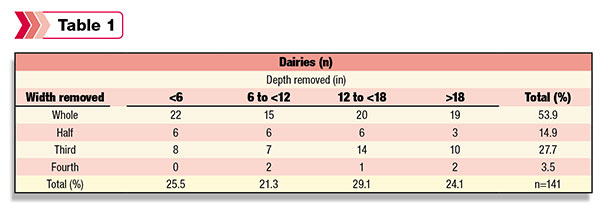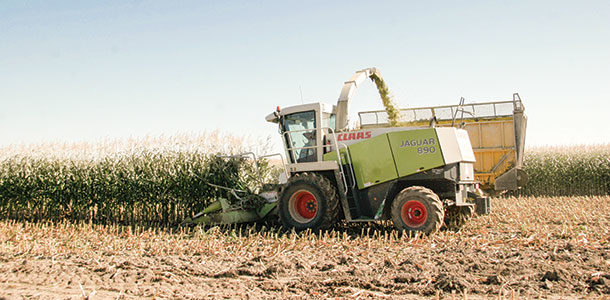Corn silage is commonly fed in California dairy operations as it provides a source of digestible fiber and readily fermentable energy for dairy cattle. In recent years, emphasis has been placed on homegrown, high-quality silage and reducing silage losses to offset increasing commodity prices.
This is particularly important for California dairy production systems, where feed is the major operating cost. In 2012, feed accounted for 65 percent of the total cost to produce milk in California.
In spring 2013, a silage management survey was mailed to dairy producers in California’s San Joaquin Valley. In this article, we’ll describe some of the key findings of the survey.
General information
Response rate was 14.5 percent with 161 returned surveys. Average herd size was 1,512 milking cows, with a median herd size of 1,200 cows.
Deciding silage harvest
On most dairies, the harvest date was decided by the dairy producer (53.5 percent). The dairy producer was aided by the grower, custom-chopper and/or nutritionist in 23.3 percent of dairies.
Only four dairies involved the nutritionist in the harvest date discussion. Why is this important? Your nutritionist will formulate your herd’s ration with the corn silage you put up for an entire year. The nutritionist has to decide how to best utilize the feedstuff and will likely have a preference on crop maturity.
Monitoring during corn silage harvest
Harvesting corn silage at the correct moisture and particle length, with adequate kernel processing, is imperative to creating a high-quality feedstuff to be utilized by high-producing dairy cows. It is difficult to improve these parameters once the feed is ensiled, so monitoring should take place throughout harvest to ensure the desired, quality end product.
Dry matter
Whole-plant corn dry matter (DM) is variable, even within a single field. From the 2013 survey, two-thirds of respondents evaluated DM during harvest, using either a Koster tester or sending samples to a commercial lab for analysis. However, only 11 percent of dairy producers reported a sampling frequency greater than six times per day. Knowing the DM at harvest will serve to:
- Adjust settings for theoretical length of cut and roller opening for kernel processing throughout harvest.
- Estimate tonnage of DM going into a silage structure. Previous work has identified sampling DM once per hour can reduce error in yield estimations to plus or minus 3 percent of actual forage removal. Taking a single sample to estimate DM for yield determination could overestimate or underestimate removal by as much as 20 percent in a single field of corn silage.
On-farm methods such as the microwave method or use of a Koster tester can give us DM information in less than an hour. There is also the opportunity to use NIR technology, either on the chopper or with a mobile unit at the silage pit. The advantage of NIR technology is immediate feedback, with cost being a major drawback.
Particle length
Particle length is especially critical when corn silage is the major, or only, source of effective fiber in the ration. If corn silage is cut too short, it could affect rumen health and function in cows, whereas longer particles are easier for animals to sort out of the TMR.
It is imperative to discuss harvest parameters with the dairy nutritionist to ensure adequate particle length is achieved. In the current survey, 80.4 percent of dairies monitored chop length, with 4 percent using the Penn State Shaker Box or a tape measure to complete the task.
Kernel processing
Kernel processing should result in 95 percent of corn kernels cracked, with at least 70 percent of the pieces smaller than one-quarter of a kernel. Kernel processing improves starch digestion, handling and packing of material, fiber utilization, feed intake and reduces feed sorting.
The most obvious consequence of improper processing will be corn kernels in feces when feeding corn silage. Samples evaluated for corn silage processing score between 2009 and 2011 were ranked as follows: 42 percent inadequately processed, 51 percent adequately processed and only 7 percent optimally processed.
Based on the 2013 survey, approximately 10 percent of dairies are still not processing kernels, and only half of those are considering adopting this practice in the future. Most dairies (92.5 percent) monitored kernel processing at some point during silage harvest.
Suggested monitoring at the silage structure
At least every hour, sample a truckload of forage for:
- On-farm DM determination
- Length-of-cut evaluation
- Kernel processing evaluation
Results should be communicated to the dairy producer, farming operation (if a separate entity) and the custom-harvester crew to make any necessary adjustments.
Silage feeding
Only 11.1 percent of responding producers waited more than eight weeks before starting to feed new silage. Most dairies use a front-end loader to remove silage from the face (85.1 percent), with fewer using a silage defacer (4.1 percent) or rake (10.8 percent). The width and depth of the face removed is presented in Table 1.

Future harvest and packing considerations
In the 2013 silage survey, dairy producers were asked to rank various practices as:
1. I am already doing this.
2. I would like to do this in the future.
3. I will not do this in the future.
As expected, most dairies currently kernel-process corn silage, with very few dairies reporting it would not be done in the future. Increasing the silage storage area was reported as a practice to consider in the future by more than half the respondents, while about one-third of the dairies would also like to increase the number of packing tractors, plant brown mid-rib varieties and create drive-over piles.
Final thoughts
Corn silage is a valuable commodity. Dairy producers should invest time and effort to coordinate growers, pest control advisers, custom-harvesters and nutritionists to work toward the same goal: maximizing quality and quantity of the crop harvested and ensiled.
Prior to harvest, it is very important that the silage team works together to set the harvest date and to decide the desired dry matter, length of chop and kernel processing at harvest. During harvest, monitor the fresh forage material for dry matter, kernel processing and chop length and ensure delivery rate is adequate and packing is appropriate. PD
Noelia Silva-del Rio is also a dairy adviser with University of California Cooperative Extension.
References omitted due to space but are available upon request. Click here to email an editor.
Photo by PD staff.

Jennifer Heguy
Dairy Farm Adviser
University of California Cooperative Extension







